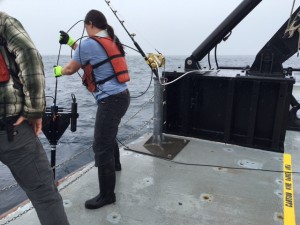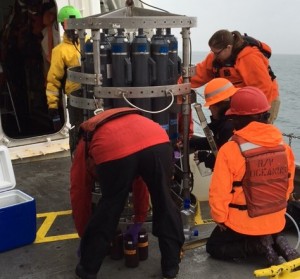There were many firsts for me Monday and Tuesday.
On Monday night, I slept for the first time on the ship while it was moving. Laying in my top bunk, swaying side to side, I could hear the water moving and waves hitting the side of the boat. The motion of the ship rocked me to sleep, but every so often the boat would rock further sideways, and I would have to brace myself so I wouldn’t fall out of the top bunk. I could also hear the CTD hitting the deck periodically while the night crew did their work.

On Tuesday morning, I took my first shower on board the ship. The stall shower is not bad — hot water and good water pressure – but you do have to hold on to the wall with one hand while washing with the other.
I was also put to work on Tuesday, helping to collect water samples from the CTD. Once the CTD is back on the deck and secure, bottles of water are collected for analysis in the lab. It may sound easy, but it can be wet as waves splash over the side onto the deck while you are kneeling on the ground collecting samples.
I also watched the deployment of the hyper pro, an instrument used by Angel White, a biological oceanographer. White’s group is looking at the phytoplankton piece of winter production in the coastal ocean.
The hyper pro, which they release over the back of the boat, allows them to see how far down light penetrates the water and the quality of the water. This will tell the researchers how much light is available for phytoplankton to perform photosynthesis.
In addition to the hyper pro, they are also filtering water samples to look for different pigments, which will tell them about the different type of phytoplankton in the water. They are also labeling water samples with a tracer, Carbon-13. They then incubate these samples, mimicking the ocean conditions, to see how much of the tracer is being taken up by phytoplankton. This will give them information about the rate of photosynthesis.
Another instrument on the ship is continuously monitoring the surface water as the ship is moving to fill in gaps between sampling with the CTD. This instrument is looking at optical properties of the water, florescence of chlorophyll in the water, and particulate size, color and composition. This information can tell researchers if the conditions are right for production to occur.
After finishing the Umpqua Hydro Line Tuesday morning, we headed north along the coast back to the Newport Hydro Line. Along the way, we zig-zagged in and out of the freshwater plume, and took periodic samples and measurements.
Nanci Bompey is AGU’s public information manager. She is spending a week aboard the R/V Oceanus with scientists from Oregon State University (OSU) who are studying the role that small rivers play in the productivity of the coastal ocean during the winter. Click here to read Nanci’s previous blogs from this trip.

